-
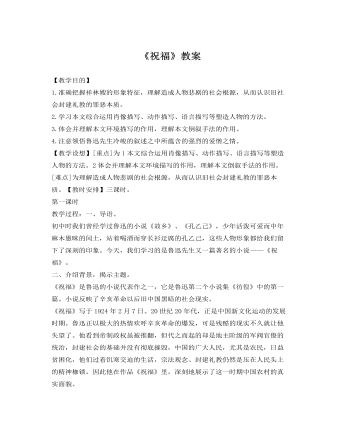
人教版高中语文《祝福》教案
C.人们的态度:“大家仍然叫她祥林嫂”,称呼依旧。这一淡淡的似乎不经意的过渡语,在具体语境中却隐含着深刻的蕴涵,反映出鲁四一家对祥林嫂的第二次婚姻冷酷而坚决地不予承认的态度。“仍然叫她祥林嫂”,而不是“贺六嫂”,绝不是习惯使然,而是反映了封建礼教观念对寡妇再嫁的完全否定。人们叫她的“声调和先前很不同”;“也还和她讲话,但笑容却冷冷的了”。整个鲁镇社会在伦理观念上与鲁四仿佛是形成了共识的,音调的变化,笑容的冷冷,反映出人物关系的变化,充分表现出社会环境与祥林嫂的严重对立。77人们很少同情和怜悯她,对她讲述的“阿毛的故事”很快就厌倦了,并把她作为取笑的对象。人们对祥林嫂的态度,使她感到痛苦与迷惑。她不时地向人们诉说着自己不幸的遭遇,她的精神却惨遭蹂躏。而柳妈的说鬼又给祥林嫂新的打击。D.柳妈说鬼:柳妈是一个怎样的人?祥林嫂为什么要化那么大的代价去捐门槛?捐门槛后祥林嫂有哪些变化?
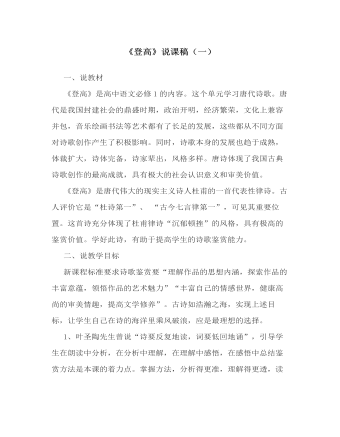
《登高》说课稿(一) 统编版高中语文必修上册
学生借助对对联的赏析,回味杜甫穷年漂泊的一生,体会杜甫作为一个深受儒家思想影响的读书人,忠君念阙,心系苍生的伟大情怀。(这一设计理念源于孟子所云:“诵其文,读其诗,不知其人,可乎?是以论其世也。”知人论世是鉴赏诗歌的第一步 )(二)研读课文1、初读,朗读吟诵,感知韵律美。要求学生读准字音,读懂句意,体会律诗的节奏、押韵的顺畅之美。2、再读,披词入情,感受感情美。让学生用一个字概括这首诗的情感内容。(此教学设计是从新课标要求的文学作品应先整体感知,培养学生归纳推理的逻辑思维能力出发进行的设计。)其答案是一个“悲”字,由此辐射出两个问题:诗人因何而“悲”?如何写“悲”?(此问题设计顺势而出,目的在于培养学生探究问题的能力。)
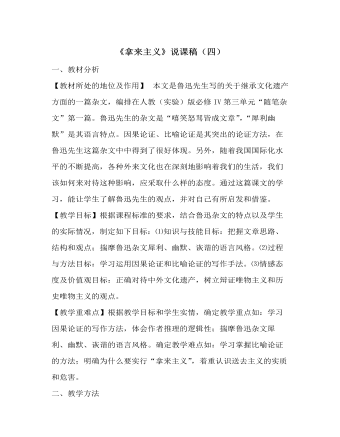
《拿来主义》说课稿(四) 统编版高中语文必修上册
【教学目标】根据课程标准的要求,结合鲁迅杂文的特点以及学生的实际情况,制定如下目标:⑴知识与技能目标:把握文章思路、结构和观点;揣摩鲁迅杂文犀利、幽默、诙谐的语言风格。⑵过程与方法目标:学习运用因果论证和比喻论证的写作手法。⑶情感态度及价值观目标:正确对待中外文化遗产,树立辩证唯物主义和历史唯物主义的观点。【教学重难点】根据教学目标和学生实情,确定教学重点如:学习因果论证的写作方法,体会作者推理的逻辑性;揣摩鲁迅杂文犀利、幽默、诙谐的语言风格。确定教学难点如:学习掌握比喻论证的方法;明确为什么要实行“拿来主义”,着重认识送去主义的实质和危害。二、教学方法教学应坚持“以学生为主体”的原则,尽可能发挥学生学习的能动性和主动性,培养学生独立思考的能力,调动学生学习积极性,因此本文采用“疑问教学法”相对合适。
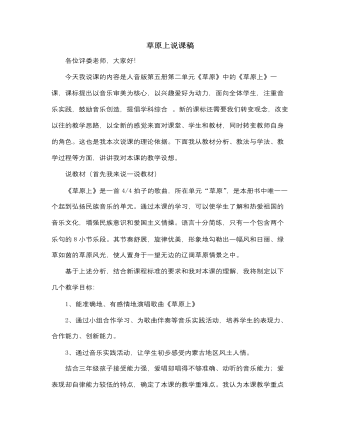
人音版小学音乐三年级上册草原上说课稿
(五)课后延伸,资源共享(进入本课的最后一个环节)让学生欣赏著名的蒙古族器乐曲《赛马》、《牧歌》;欣赏耳熟能详的蒙古族歌曲《吉祥三宝》、《美丽的草原我的家》等。【因为一个、两个的音乐作品并不能让孩子们完全的认识、领悟蒙古族音乐的丰富魅力及内涵。我利用课堂上的有效时间,趁热打铁,让他们从多角度体验音乐音响形式中的美,陶冶情操,启迪智慧。这样富有弹性的设计,有利于培养学生的创新思维,使音乐教学充满生机与活力。】总之,这节课的设计是融合律动、歌曲、表演、创编为一体的较为全面的综合课。以学生发展为前提,以“主体、创新”为主题,以“草原”为主线贯穿整堂课,充分利用多媒体教学,通过走进大草原、感受大草原、歌唱大草原、体验创新,激发热情、课后延伸,资源共享几个环节的教学,圆满地完成了本课的教学任务,落实了教学目标。
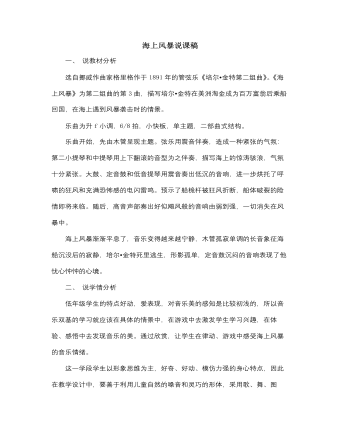
人音版小学音乐二年级上册海上风暴说课稿
[设计意图:通过这一环节,学生参与到《海上风暴》表演中,感受大海,对大海进行了全面的认识,更让学生明白了遇到困难要团结,团结力量大]你们真勇敢,经过我们的共同努力终于战胜了风暴,迎来了晴天(课件说明:出示图片平静的大海,小船在海面上静静地移动,并以歌曲《海》作为背景音乐)四、演绎大海的歌1、师:今天我们感受了平静的大海,欣赏了有风暴的大海,你喜欢怎样的海?2、教师听学生的各种说法及理由之后,说:那就让我们一起来体会一下不同的海吧。(学生感觉像是坐上一艘大船,听音乐表演,听到平静的大海的音乐就根据伴奏音乐表演并歌唱《海》,听到有风暴的海的音乐就用表情和身体动作来表现。)3、朋友们,你们的海之旅收获还真不少呀,通过此次旅行,我想每一位小朋友都有一个自己心中的大海,希望小朋友们在课后,把你心中的大海表演给爸爸妈妈看。
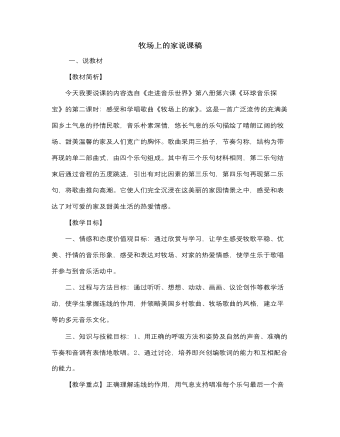
人音版小学音乐五年级上册牧场上的家说课稿
朴素深情悠长气息松散的节奏晴朗辽阔甜美温馨宽广的胸怀5、当学生唱两三次后,歌词就唱得较熟了,这时可以启发学生处理好歌曲中A乐句与B乐句的演唱力度,唱出mf与mp的力度对比。还可以启发他们用不同的演唱形式来表现音乐。6、教师范唱,最后全班用高位置的混声和圆润的音色来深情地演唱歌曲《牧场上的家》,尽情地表达对家乡的热爱。7、展示评价三、第三环节:拓展创编歌词(10分钟)听中编。同学们自编歌词,尽情歌唱自己的家。如:“猎德的家”、“我的家”、等。引导学生可根据我校综合实践课程的特色来创编歌词,歌唱猎德村改造前后的变化或心理感受。这时采用示范的方式展示和演唱老师创作的歌词,再让小组讨论并展示,还可让他们加上自制的打击乐器伴奏。最后是中肯的评价。

新人教版高中英语必修3Unit 1 Festivals and Celebrations-Reading for writing教学设计二
Step 3 Analyzing article structureActivity 31. Teachers raise questions to guide students to analyze the chapter structure of this diary and think about how to describe the festival experience. (1)What should be included in the opening/body/closing paragraph(s)?(2)How did the writer arrange his/her ideas?(3)What kind of interesting details did the writer describe?(4)How did the writer describe his/her feelings/emotions during the event?2. Students read and compare the three sentence patterns in activity 2. Try to rewrite the first paragraph of the diary with these three sentence patterns. After that, students exchange corrections with their partners. Such as:●This was my first time spending three days experiencing the Naadam Festival in China’s Inner Mongolia Autonomous Region and it was an enjoyable and exciting experience. ●I'll never forget my experience at the Naadam Festival because it was my first time to watch the exciting Mongolian games of horse racing, wrestling, and archery so closely. ●I'll always remember my first experience at the Naadam Festival in China’s Inner Mongolia Autonomous Region because it was so amazing to spend three days witnessing a grand Mongolian ceremony. Step 4 Accumulation of statementsActivity 41. Ask the students to read the diary again. Look for sentences that express feelings and emotions, especially those with the -ing form and the past participle. Such as:● …horse racing, wrestling, and archery, which are all so exciting to watch. ● some amazing performances● I was surprised to see…● I was a little worried about. . . ● feeling really tiredOther emotional statements:●I absolutely enjoyed the archery, too, but the horse races were my favourite part. ●I'm finally back home now, feeling really tired, but celebrating Naadam with my friend was totally worth it. ●He invited me back for the winter to stay in a traditional Mongolian tent and cat hot pot. I can’t wait!2. In addition to the use of the -ing form and the past participle, the teacher should guide the students in the appreciation of these statements, ask them to memorize them, and encourage them to use them reasonably in writing practice.

新人教版高中英语必修3Unit 1 Festivals and Celebrations-Reading for Writing教学设计一
The topic of this part is “Write about your festival experience”.During the Listening and Speaking and Talking, students are just asked to say out their festival experiences such as the Spring Festival, Mid-autumn Day, but this part students will be asked to write down their own festival experiences. During the reading part, it introduces the Naadam Festival in Inner Mongolia Autonomous Region, which can give students a good example to imitate. Students not only learn the festival, but touch and feel the Inner Mongolian’s character, the spirit and cultural atmosphere, which can help students form the cultural awareness and learn to enjoy and value the diversity of Chinese culture.Concretely, the dairy tells the experience that the author spent the Naadam Festival in Inner Mongolia Autonomous Region with his/her friend. The structure is clear. In the opening paragraph, it introduces the topic of the Naadam Festival and the whole feeling. Then it introduces the items of the festival like the ceremony, wrestling and horse racing. Finally, it summarizes this experience. Because this part is a travel journal, we must guide students pay more attention to these details: 1. use the first person. 2. use the past tense to tell the past thing and use the present or future tense to describe the scenery. 3. use the timeline to tell the development. 4. be careful for the author’s psychology, emotion and feeling, etc.1. Read quickly to get main idea; read carefully to get the detailed information about Naadam Festival.2. Learn the structure of the reading article and language.3. Write an article about a festival experience4. Learn to use the psychology, emotions and feeling in the writing.1. Write an article about a festival experience.2. Use the structure of the reading article and language.

新人教版高中英语必修3Unit 3 Diverse Cultures-Reading for Writing教学设计
The topic of this part is “Describe a place with distinctive cultural identity”.This section focuses on Chinese culture by introducing Chinatown, whose purpose is to show the relationship between the Chinese culture and American culture. The Chinese culture in Chinatown is an important part of American culture. Chinatown is an important window of spreading Chinese culture and the spirit homeland of oversea Chinese, where foreigners can experience Chinese culture by themselves.Concretely, the title is “Welcome to Chinatown!”, from which we can know that the article aims at introducing Chinatown. The author used the “Introduction--Body Paragraph--Conclusion” to describe the people, language, architecture, business, famous food and drinks and people’s activities, which can be a centre for Chinese culture and shows its unique charm.1. Read quickly to get main idea; read carefully to get the detailed information.2. Learn the characteristics of writing and language.3. Learn to introduce your own town according to the text.4. Learn to correct others’ writing.1. Learn the characteristics of writing and language.2. Learn to introduce your own town according to the text.Step 1 Lead in ---Small talkIn the reading part, we mentioned the Chinatown of San Francisco. How much do you know about Chinatown of San Francisco ?Chinatown is a main living place for Chinese immigrants, where you can see many Chinese-style buildings, costumes, operas, restaurants, music and even hear Chinese.Step 2 Before reading ---Predict the contentWhat is the writer’s purpose of writing this text ? How do you know ?From the title(Welcome to Chinatown) and some key words from the text(tourist, visit, visitors, experience), we can know the purpose of the text is to introduce Chinatown and show the relationship between Chinese culture and American culture.
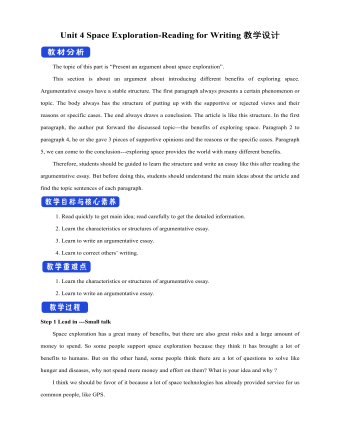
新人教版高中英语必修3Unit 4 Space Exploration-Reading for Writing教学设计二
⑦在我看来, 探索太空是值得的。As far as I am concerned, it is worthwhile to explore the space.Step 10 Writing---draftRecently, students in our class have had heated a discussion on whether space is worth exploring. Students hold different ideas about it.30% of us think space exploration is not worthwhile. They think space is too far away from us and our daily life and is a waste of money. And the money spent on space exploration can be used to solve the earth’s problems such as starvation and pollution.On the other hand,70% think space is worth exploring because we have benefited a lot from it,such as using satellites for communication and weather forecast. What’s more,with further space research,we may solve the population problem by moving to other planets one day. Also,space research will enable us to find new sources to solve the problem of energy shortages on the earth.As far as I am concerned, it is worthwhile to explore the space. Not only can it promote the development of society but also enrich our life. Step 11 Pair workExchange drafts with a partner. Use this checklist to help your partner revise his/her draft.1.Does the writer explain why he/she changed/wanted to change?2.Does the writer tell how the changes have improved or will improve his/her life?3.Is the text well-organised?4.Does the writer use words and expressions to show similarities and differences?5.Are there any grammar or spelling errors?6.Does the writer use correct punctuation?

新人教版高中英语必修3Unit 4 Space Exploration-Reading For Writing教学设计一
另一方面,其余的人反对这个计划,因为它可能会导致一些不好的影响。7.I hold the belief that space exploration not only enable us to understand how the universe began but also help us survived well into the future.我坚信探索太空不仅能够使我们了解宇宙的起源而且能够帮助我们更好地走进未来。8.I think we should spend more time and money exploring space so as to provide new and better solutions to people's shortterm and longterm problems.为了给人类的短期和长期问题提供更新和更好的解决方法,我认为我们应该花更多的时间和金钱来探索太空。9.From my point of view,it is wrong of young people to depend on their telephones too much,which may do harm to both their physical and mental health.在我看来,年轻人过度依赖手机是不对的,因为它们可能会对他们的身心健康都有害。最近你班同学就“人类是否应该进行宇宙探索”这个问题进行了激烈的讨论。有人认为,探索宇宙不仅让人类更好地了解宇宙的发展,还可以用来指导农业生产,以及把一些探索太空的高新技术用于现实生活;也有一些人认为探索太空花掉了大量的人力物力;影响了人们的生活水平。请你根据以下情况写一篇报告并发表自己的观点。注意:1.写作内容应包括以上全部要点,可适当发挥,使上下文连贯;

新人教版高中英语必修3Unit 5 The Value of Money-Reading for Writing教学设计二
2. 您能看到, 我头发太长了。You can see that my hair is much too long.3. 无论什么时候, 只要您想回来就回来。Please come back whenever you want.4. 您仅有很少的头发要理! You only have too little hair to cut !5. 为您服务是我的荣幸!It is my honour to serve you!Step 9 Writing(Henry is walking down the street when he sees a sign for a place that cuts hair. He decides to have it cut. )H=Henry B=BarberH: Good afternoon, I’d like to have my hair cut, if I may. (The barber looks at Henry’s hair and continues cutting another man’s hair. ) Er, I’d really like a haircut. As you can see it’s much too long. B: (in a rude manner) Yes, I can see that. Indeed, I can. H: Fine, well, I’ll have a seat then. (He sits in one of the barber’s chairs. The barber turns to look at Henry. )B: It’s quite expensive here, you know! Are you sure you can afford it?H: Yes. I think so. (After his hair is cut, the barber tells Henry how much he must pay. Henry shows the barber the bank note. )B: Why Mr. . . (looks shocked)H: Adams. Henry Adams. I’m sorry. I don’t have any change. B: Please don’t worry! (wearing a big smile) Nothing to worry about! Nothing at all! Please come back whenever you want, even if you only have too little hair to cut! It will be my honour to serve you!Step 10 Pair workExchange drafts with a partner. Use this checklist to help your partner revise his/her draft.1. Are all the elements of a play included and in good order ?2. Do the character use suitable language ?3. Are the stage directions clear and useful ?4. Is the plot clear and exciting enough ?

新人教版高中英语必修3Unit 5 the value of money-Reading For Writing教学设计一
【参考范文】Narrator:(Henry is smiling as he leaves the restaurant. As he is walking down the street, he sees a sign for a place that cuts hair. He decides to get it cut. )H=Henry;B=Barber;R=rude manH:Good afternoon, I'd like to get a cut, if I may. (The barber looks at Henry's hair and continues cutting another man's hair. )Er, I'd really like a haircut. As you can see it's much too long. B:(in a rude manner) Yes, I can see that. Indeed, I can. H:Fine, well I'll have a seat then. (He sits in one of the barber's chairs. The barber turns to look at Henry. )B:It's quite expensive here, you know!Are you sure you can afford it?H:Yes. I think so. (In comes the rude man. )R:Hey you there. I need a haircut quickly. Can you do me straightaway?B:All right, then, get in the chair and I'll see what I can do. R:Thank you. (sits down in one of the barber's chairs)H:Excuse me, but I was here first. Aren't you going to do my hair first?B:This man's in a hurry. H:Well so am I!I insist that you cut my hair first. B:OK, but I'll have to be quick. This gentleman is waiting. H:Thank you. (They both become quiet. After his hair is cut, the barber tells Henry how much he must pay. Henry shows the barber the bank note. )B:Why, Mr . . . (looks shocked)H:Adams. Henry Adams. I'm sorry, I don't have any change. R:You're that Mr Adams! Well,I'm glad I waited or I might never have known it was you. B:Why, Mr Adams, please don't worry!(wearing a big smile) Nothing to worry about!Nothing at all!Please come back any time, even if you only need too little hairs cut!It will be my honour to serve you!
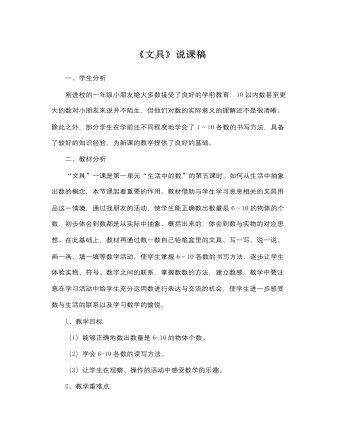
北师大版小学数学一年级上册《文具》说课稿
一、学生分析刚进校的一年级小朋友绝大多数接受了良好的学前教育,10以内数甚至更大的数对小朋友来说并不陌生,但他们对数的实际意义的理解还不是很清晰。除此之外,部分学生在学前还不同程度地学会了1~10各数的书写方法,具备了较好的知识经验,为新课的教学提供了良好的基础。二、教材分析“文具”一课是第一单元“生活中的数”的第五课时。如何从生活中抽象出数的概念,本节课起着重要的作用。教材借助与学生学习息息相关的文具用品这一情境,通过找朋友的活动,使学生能正确数出数量是6~10的物体的个数,初步体会到数都是从实际中抽象、概括出来的,体会到数与实物的对应思想。在此基础上,教材再通过数一数自己铅笔盒里的文具、写一写、说一说、画一画、填一填等数学活动,使学生掌握6~10各数的书写方法,逐步让学生体验实物、符号、数字之间的联系,掌握数数的方法,建立数感。
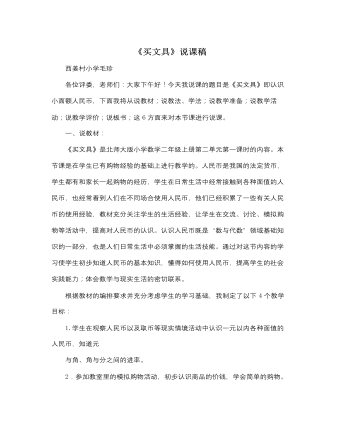
北师大版小学数学二年级上册《买文具》说课稿
(一)、情境导入通过播放笑笑和淘气在文具店购买文具活动的视频片段,唤起学生已有的知识和经验,使学生想到“买东西要使用人民币”。又因为二年级孩子年龄较小,社会经验不足,上市场、超市购物的机会也少,对人民币只是初步的认识,对于要用到钱才能买到东西这一朴素的等价交换的原则只有初步的意识。所以借此机会激发学生想不想和笑笑、淘气一起到文具店里去购买文具呢?从而引出课题:买文具。(二)、认识小面额人民币学生在生活中经常看到人民币,有时还使用人民币,因此我首先让学生互相交流:你知道有哪些面值的人民币?根据学生的回答,老师有序地进行板书:1角、2角、5甬1元、2元、5元10元、20元、50元100元在这一环节中我仅作为引导者,引导学生相互交流,在师生互动中完成对已有知识经验的归纳与延伸,通过小组合作,互相交流,让全体学生参与学习过程,在学习过程中有意识培养学生细心观察、仔细倾听、善于总结的良好习惯。
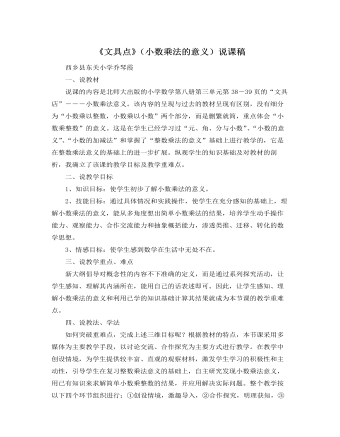
北师大版小学数学三年级上册《文具点》说课稿
(三)深化运用,巩固新知在这个环节,我设计四组闯关题。第一关是试一试:①买3支铅笔需要多少元?②买两把直尺需要多少元?这关是模仿性练习,让学生运用已学的数学知识解决实际问题。第二关是说一说,在学生初步感知了小数乘法的意义后,我给出了6个算式,让学生说一说他们所表示的意义。第三关是填一填,即根据加法算式写乘法算式和根据乘法算式写加法算式,这两关是提高性练习。第四关是涂一涂,即根据算式涂涂得出结果。是为了进一步加深学生对小数乘法意义的理解。第五关是想一想:0.3×4=0.6,4×0.3=?这关是深化性练习,一是让学生明白整数乘法的交换律在小数乘法中同样适用,二是让学生体会一个整数乘小数的意义也是求几个几是多少。第六关是两组口算练习。第七关是两道解决问题。主要是在学生理解小数乘整数的意义的基础上复习以前所学的数量关系。
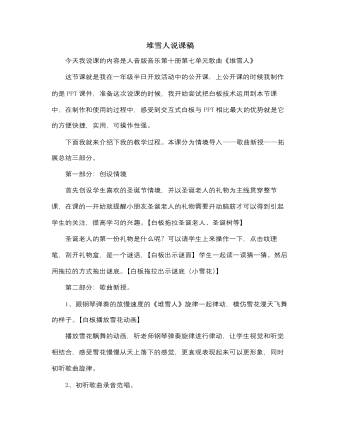
人音版小学音乐五年级上册堆雪人说课稿
第二首是中国歌曲《龙咚锵》,欣赏后师生共同讨论下我国过年的习俗,然后在《堆雪人》伴奏的背景音乐下,观看中国过年时的各种场景【白板播放歌曲拖拉图片】这部分环节的设计是让学生初步感受不同地域的音乐风格和音乐所表达的“过新年”热闹氛围,了解过年的风俗,在音乐学习中受到节日文化的熏陶,感受音乐与生活、与自然的关系。最后播放《堆雪人》视频,【白板播放歌曲视频】学生在《堆雪人》的音乐声中,在亲身制作的贺年卡上,贴上雪花窗花贴纸,作为新年的礼物送给父母。感恩父母感受生活的幸福,同时《堆雪人》这首歌曲的旋律也贯穿了整节音乐课。本次是我把电子白板运用到音乐教学中的初次尝试,在制作与操作的过程中明显还不够熟练,有待提高。请在座的各位领导老师们多提宝贵意见,谢谢大家。
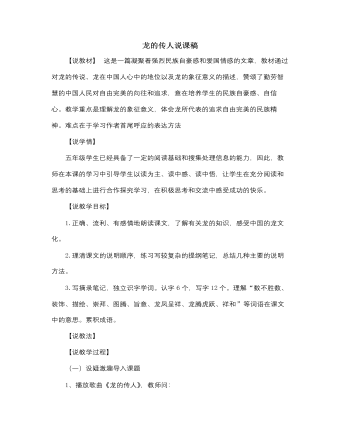
人音版小学音乐六年级上册龙的传人说课稿
2、指名读喜欢的部分,师生评议。3、播放歌曲,学生跟唱,引发情感共鸣。[在引导学生走进文本,受到情感熏陶的基础上,进一步引导学生将作者字里行间流露的深情通过朗读表达出来,激发学生与作者情感上的共鸣。使学生的民族自豪感得到培养(五)、拓展延伸1、搜集有关龙的资料,创办专题读书笔记。[这个问题的设计,是在学生深读积累的基础上进行拓展延伸,为学生创造性的学习提供一个空间,从而使学生自主学习的能力得到培养,体现语文工具性与人文性的统一。] 反思:本节课围绕“质疑、解难,读书、感悟,讨论、交流”展开教学,通过听歌导入,图片展示,让学生“乐中求知”,通过自读感悟,小组合作交流,教给学生学习方法,培养学生自主学习的能力,同时教师的相机点拨,又突出了重点。将以人为本,以学生发展为本的教育思想落到了实处。

人音版小学音乐二年级上册小拜年说课稿
打击乐器是小学生喜欢的乐器。让学生在音乐课上演奏打击乐器,不但可以提高学生的学习兴趣,同时也能培养对音乐的感知力。让学生为乐曲加上打击乐器伴奏。在鼓、钹声中,学生的参与意识被激发。加强了学生对音乐的理解,增强了音乐的表现力。(五)拓展延伸 。 1、让音乐与生活沟通起来音乐本来就是从生活中创造出来的。我们在音乐教学过程中根据教学需要,实现教师、学生、教材、教具、教学环境与生活的多方面横向联系,及他们之间的相互作用和影响。 (六)、课堂小结。课堂小结:是在完成某项教学任务的终了阶段,教师富有艺术性的对所学知识和技能进行归纳、总结和升华的行为方式,它常用于课堂的结尾,所以形象地被称作"豹尾"。完善、精要的"小结",可以使课堂教学锦上添花,余味无穷,让学生达到前后浑然一体的美妙境界,以激发学生学习音乐课的热情,同时性情也受到熏陶。
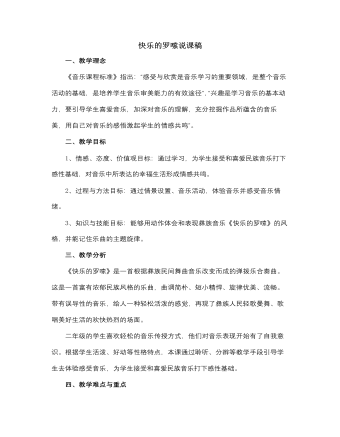
人音版小学音乐二年级上册快乐的罗嗦说课稿
一、教学理念《音乐课程标准》指出:“感受与欣赏是音乐学习的重要领域,是整个音乐活动的基础,是培养学生音乐审美能力的有效途径”,“兴趣是学习音乐的基本动力,要引导学生喜爱音乐,加深对音乐的理解,充分挖掘作品所蕴含的音乐美,用自己对音乐的感悟激起学生的情感共鸣”。二、教学目标1、情感、态度、价值观目标:通过学习,为学生接受和喜爱民族音乐打下感性基础,对音乐中所表达的幸福生活形成情感共鸣。2、过程与方法目标:通过情景设置、音乐活动,体验音乐并感受音乐情绪。3、知识与技能目标:能够用动作体会和表现彝族音乐《快乐的罗嗦》的风格,并能记住乐曲的主题旋律。三、教学分析《快乐的罗嗦》是一首根据彝族民间舞曲音乐改变而成的弹拨乐合奏曲。这是一首富有浓郁民族风格的乐曲,曲调简朴、短小精悍、旋律优美、流畅。